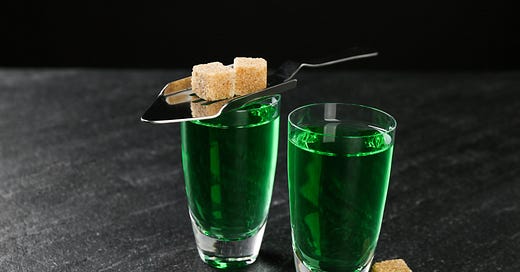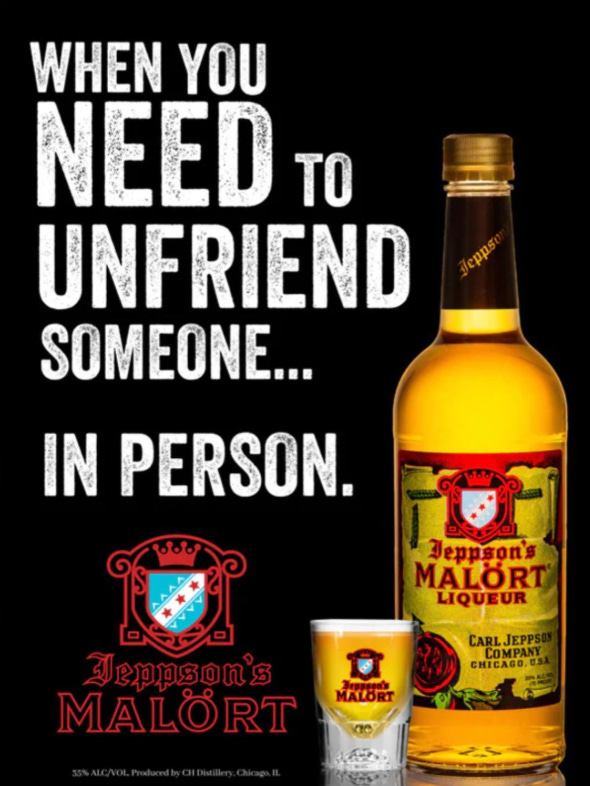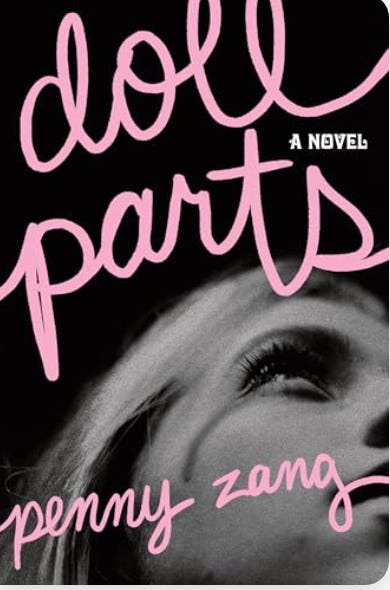Let’s talk dark drinks. I refer not to simple concoctions that seem dark, like black lager, Imperial stouts, espresso martinis, or the like. I am talking about drinks that are Serious About Themselves.
We’ll start with absinthe.
“After the first glass of absinthe you see things as you wish they were. After the second you see them as they are not. Finally you see things as they really are, and that is the most horrible thing in the world.”
~ Oscar Wilde
I mean, that sounds like bourbon, or a bunch of ill considered margaritas, to me…but what do I know?
Did you know that absinthe was illegal in these United States until 2007? I mean, that’s pretty recent, considering. It was outlawed along with all other legal consumption of alcohol with Prohibition but didn’t get out of purgatory until 2007? Why?
A lot of it is as simple as a bad rep. Which is to say, if TikTok had been around then, something called GreenFairyTok would’ve been A Thing. A lot of “why not poisonous if poisonous-shaped” posts and other nonsense would’ve been tossed around about this intensely green and equally intensely licorice-flavored bevvie. Its (forbidden but yet visible) avatar would’ve been a green fairy, and so on.
The Green Fairy bit is because it was sometimes known as La Fee verte or The Green Lady because it (supposedly) caused hallucinations. I guess people saw green fairies….? Anyway, when the 21st Amendment ended Prohibition in 1933 the ban on absinthe remained. In fact, that ban remained in effect until 95 years later when the TTB along with the FDA authorized the sale of Absinthe in the U.S.
With some caveats. But to understand them we must first understand what comprises the stuff. Absinthe is a high (110-144) proof neutral spirit, that’s produced a lot like gin, in that it’s infused to botanicals. The three herbs most used in production of absinthe are grande wormwood, green anise and sweet fennel. Traditionally, the alcohol is infused a second time before bottling to intensify the flavor and create the signature green color.
Anise and fennel get you that licorice-ness. The key ingredient is wormwood (Artemisia absinthium). Wormwood is the source for “thujone”. Technically speaking, the government never banned Absinthe but they banned the thujone inside the Absinthe. It was believed that the thujone was the hallucinogenic bit and so technically that’s what was illegal. As of 2007, absinthe containing thujone is legal as long as the bottle contains less than 10 parts per million of thujone.
The folks at the Tobacco and Trade Bureau (Aforementioned TTB)—the group that must approve labels for anything that contains alcohol in the U.S. set out a few rules at this point as well. To wit:
Since there is no class and type understanding, the term “absinthe” may not be used as the brand name or fanciful name, or as part of the brand name or fanciful name, because otherwise it would appear as a class and type designation. The term “absinthe” may not stand alone on the label; it must be accompanied by additional or dispelling information so as not to appear as the class and type designation.
Any artwork or graphics on the label, advertising, and point of sale materials using the term “absinthe” may not project images of hallucinogenic, psychotropic, or mind-altering effects.
TTB will include the following qualification statement on all approved COLAs showing the term “absinthe” on a label: “The finished product must be ‘thujone-free’ … and so on.
So if you think that labels on absinthe are free and clear of anything fun, you are probably right.
There are plenty of myths surrounding this stuff, as you might imagine. But first read this super informative post about the Death of the Green Fairy. The myths about it being hallucinogenic because of the thujone that is created are false, and modern absinthe must adhere to the low thujone rules anyway. One can only guess how high it was at one time, of course, which could have lead to the hallucinogenic reputation.
While it is legal in the U.S. (now), the whole sugar cube thing is part myth, part reality.
It’s not a flaming sugar cube (myth) but the use of a sugar cube to serve it is a relatively recent trick invented to mask badly made absinthe and as a marketing gimmick.
Absinthe is traditionally bottled at a high proof and served straight. To serve it straight, cold water is then dripped into the drink, often through a sugar cube on a slotted spoon to sweeten the beverage because unless you love you some Malört, then I can assure that the combination of wormwood, anise, and fennel straight will make the strongest consumer cry bitter tears of pure regret. Hence, introducing water to weaken it and sugar to sweeten it.
It’s used in mixed drinks as well. You can’t make a respectable sazerac without it, for example. But some fun newer concoctions like The Green Beast (absinthe, lime juice, sugar, and water), The Necromancer (includes elderflower liqueur, Lillet Blanc, and lemon juice, or Death in the Afternoon, which is a simple mix of absinthe and champagne (which gives me a hangover just thinking about it) lean hard into its long-held rep of Hallucinations! Madness! etc.
While we’re on the subject of Drinks for Dark Times, may I present the other wormwood based booze: Malört. Brought to the U.S. and Chicago specifically from Sweden by Carl Jeppson, it’s a type of bäsk liqueur, a bitter, wormwood-flavored liqueur, which is a traditional Swedish schnapps.
Long the butt of jokes about “the taste of Chicago,” this stuff is as bitter as the day is long in the peak of summer. Descriptions like “burnt carpet,” “grapefruit peel that’s been run over by a truck,” or my personal favorite “pencil shavings and heartbreak,” abound. A quick trip down your fav social media platform’s rabbit hole will yield any number of memes about it and the city that spawned it.
What I don’t get is how absinthe = romance and sexy ennui and Malört = despair and cold Chicago winters when they are for many intents and purposes, the same damn drink, minus the green color.
What’s your go-to drink when you’re feeling low and want the booze in your glass to match it? Burnt raisin skin wine (a.k.a. Amarone)? Or maybe it’s a shot of Fireball. Perhaps you’re more of a sad whiskey drinker (like yours truly). As long as you limit yourself to one of them sort of a reward for living through….waves arms….all of this every day, I say go for it.
But do NOT forget that sugar cube if you’re reaching for the green fairy drink.
Here is a link to some brands you can study.
And here is a link to my all time favorite Malört story.
Speaking of stories, here is what I’ve read recently with a quickie review (longer ones to come for some, once they release).
If you’re a fan of dark academia settings (think: goth girls in the 80s, seances, and young friendships in all girls schools going sideways) and unique storytelling methods (think: dual timelines and placing yourself into your dead ex-friend’s life) this book should be one on your fall TBR. It releases August 26 and can be pre-ordered here and here. Full review to come…
Coincidentally, I was chatting with Penny (author of Doll Parts) about books that felt prescient to the point of scary and she recommended Parable of the Sower, which I finished and am now on Parable of the Talents (the sequel). Unfortunately the author, Octavia Butler, died before she could finished was to be a trilogy. Published in 1993 and 1998 respectively, these books open up in the year (you guessed it) 2025 when things are, shall we say slightly more messy in a literal way than things are now, but not to the point that you’d say “Nope, can’t ever see that happening. Not here, anyway.”
Maybe that’s why I want to suck some uncut absinthe through a sugar cube, huh?
What’s on your reading agenda lately?
Make it a good one.
xoxo
Liz
Let us toast to animal pleasures, to escapism, to rain on the roof and instant coffee, to unemployment insurance and library cards, to absinthe and good-hearted landlords, to music and warm bodies and contraceptives... and to the "good life", whatever it is and wherever it happens to be.
Hunter S. Thompson







